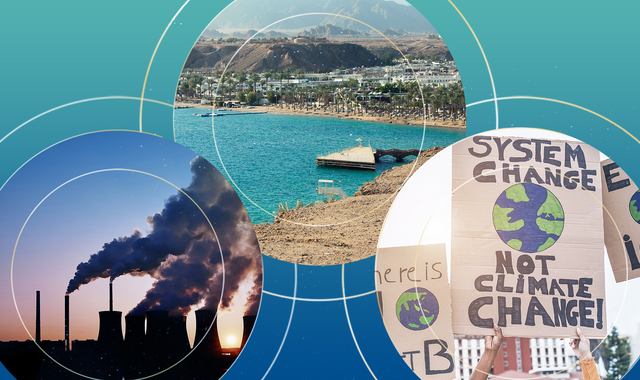COP27: What it's really like to be at the UN's climate summit and what's behind the scenes

For those who have never been to a COP event, here are five things to know about what delegates and visitors encounter at the UN's climate summit.
1. Rubbing shoulders with presidents
Enter the blue zone: the inner COP area is beyond the security cordon and only officials, media, observers and other accredited folks can go into this area, which becomes United Nations territory for the duration of the summit.
World leaders and government ministers touchdown at various parts of the two-week summit to give some oomph to the negotiations - with mixed success, it has to be said.
Many then roam around the blue zone attending talks and side events hosted by countries or industry bodies.
The access to law-makers/decision-makers is incredible. Most of the year it is hard to even get close to a minister. At a COP journalists are virtually batting them away.
On Wednesday, do you go the event with a UK minister, or incoming Brazilian president Lula?
The green zone is open to all and hosts events for delegates and the public.
2. Behind closed doors
In the negotiating rooms, sunlight- and sleep-deprived diplomats politely bring commitments to the table in the hopes others will do the same.
They wrangle over not just the promises but the wording, with battles over things like "down" vs "out" - usually ensuring it is sufficiently vague so as to allow wiggle room - otherwise it would be impossible to get the consensus needed to sign it off.
In public they will talk in vague terms about unspecified "parties" (countries) who are doing something they don't like: perhaps backtracking on the 1.5C goal or failing to cough up promised cash.
NGOs, thinktanks and other observers sit in on a lot of the talks, ensuring accountability and relaying the lowdown to the rest of the world.
In private they might name names, but on the condition of anonymity, in case they betray their diplomatic friendships.
3. Out and about
A COP is also like a trade fair for the climate.
There are vast halls of pavilions hosted by countries or industry bodies to showcase their projects, or themed around things like youth, nature, or water. The stands host talks or launches, for, say, a clean power partnership or a deal between countries or promises on cash.
Think of COP as a centre of gravity, with a whole load more events circling around it.
Limited demonstrations are allowed in the outside areas of the venue and somewhat burst the bubble of COP, reminding passers-by of the people in the real world losing their lives and livelihoods, and how many more will do so as the world warms by each tenth of a degree.
This year's protests have focused on compensation for climate change in vulnerable countries that did not cause climate breakdown, the dash for Africa's untapped gas and veganism.
4. The good: the setting
All good things come to those with coffee.
Everyone here is tired: COP is two weeks of events, talks, press conferences, meetings and networking events in the evenings. No surprise then that the stands with coffee machines seem to be the busiest (I'm looking at you, Germany...)
Racing between venues is made much lovelier - though sweatier - by the glorious setting near the Red Sea, with palm trees dotted through the venue and 29C dry sunshine. It's thirsty work...
The bad: shortages
...but food, water and internet have all been in short supply at the conference, with queues for £12(!) sandwiches taking an hour, and the limited number of water coolers running dry. Terrible wifi has also made it much harder to find your way to an event, meet people or file stories - the main reason a lot of people attend a COP.
The Egyptian presidency has taken flack for this. Queues were common in Glasgow at COP26 too. Around thirty thousand people are registered to attend a COP.
The ugly: sewage
No, that's not a reference the content of the COP, but to the leak on Wednesday that poured out over the exit road - making it unavoidable to walk through it. Delegates were sent off for the evening with the smell of excrement and disinfectant in their nostrils.
5. The serious
Of course these temporary challenges are not a patch on what many Egyptians or people in host continent Africa, or in the UK, have to contend with every day.
One of the biggest stories here has been that of imprisoned British-Egyptian pro-democracy activist Alaa Abd el Fattah, whose sister has roamed COP calling for her brother's release.
He has come to symbolise state repression in Egypt, where tens of thousands of political prisoners are detained, Human Rights Watch believes.
Read more: Activists stage muted COP27 protest amid curbs on rights in Egypt
Germany has accused Egyptian security officials of snooping at events inside the blue zone, where international rather than local law applies.
Yes, that's technically seven things, but it wouldn't be a COP if something didn't overrun.
Watch the Daily Climate Show at 3.30pm Monday to Friday, and The Climate Show with Tom Heap on Saturday and Sunday at 3.30pm and 7.30pm.
All on Sky News, on the Sky News website and app, on YouTube and Twitter.
The show investigates how global warming is changing our landscape and highlights solutions to the crisis.

 Yahoo News
Yahoo News 
